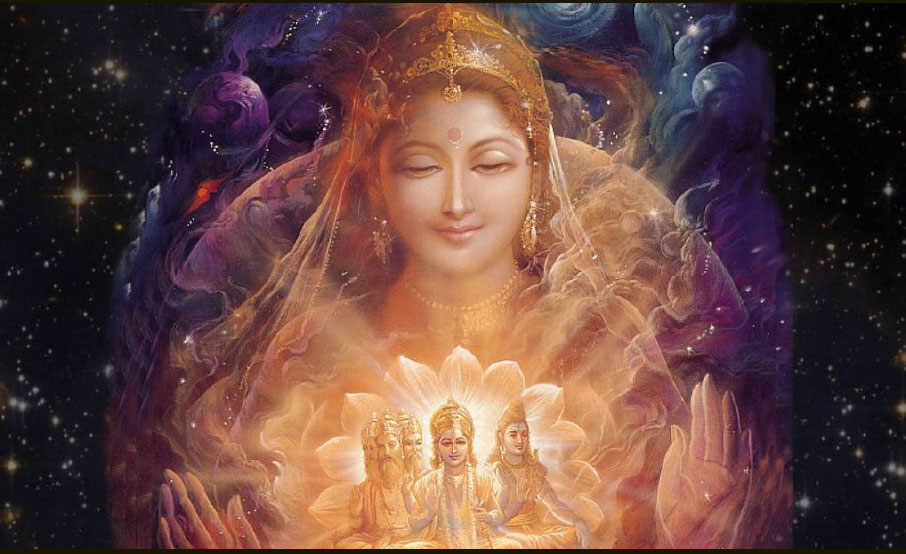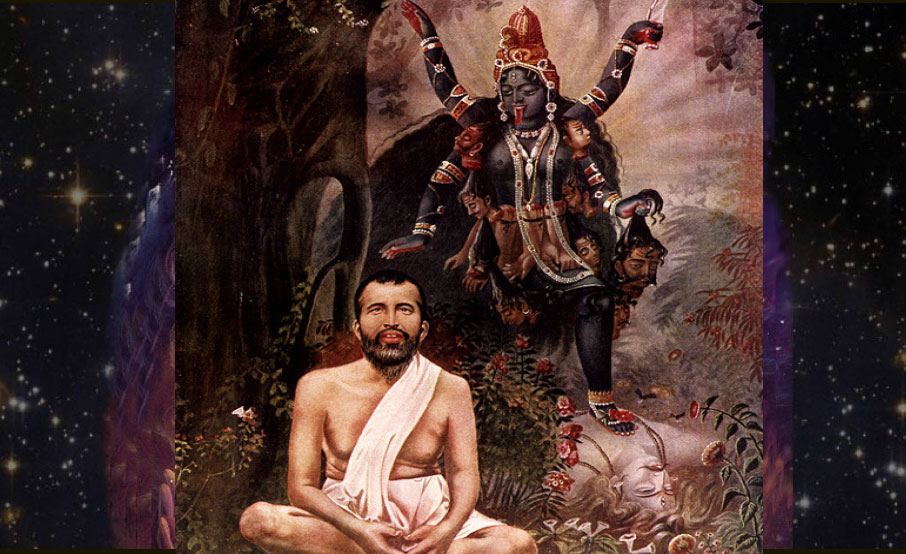The Genesis of God as Mother
The Hindus of India look upon God not only as Father but as Mother as well. They also view God as pure impersonal spirit, Brahman. God as Mother was also recognized by many cults of the Mediterranean region that existed in ancient times. Karen Armstrong, once a Catholic nun, and the author of ‘A History of God’, has documented hundreds of little Mother Goddess figurines in Europe, Asia and the Middle East, dating from the early Neolithic period. She found hardly any male effigies from that era. Then as agriculture began to transform human life, the fertility of the soil was experienced as a sacred force. The earth seemed to produce plants and nourish them as a mother gave birth to a child and fed it from her own body.
 When human beings created the plough, and later, began to build cities, more masculine quali¬ties were revered as manifestations of the divine force that kept all things in perfect order. Male gods began to personify the sacred. Still, for the early Israelites, religion was not monotheistic. The Bible shows that most of these people continued to worship gods and goddesses like Isis of Egypt and Aphrodite of Greece alongside Yahweh until they were deported to Babylon in the sixth century BC.
When human beings created the plough, and later, began to build cities, more masculine quali¬ties were revered as manifestations of the divine force that kept all things in perfect order. Male gods began to personify the sacred. Still, for the early Israelites, religion was not monotheistic. The Bible shows that most of these people continued to worship gods and goddesses like Isis of Egypt and Aphrodite of Greece alongside Yahweh until they were deported to Babylon in the sixth century BC.
It was only in exile did the religion of Juda¬ism become fiercely monotheistic in its denial of any other gods or goddesses. Temples and syna¬gogues were rid of images of God, mother cults were suppressed and banished out of existence.
So while Judaism and Christianity destroyed all cults that preferred God as Mother, in India alone, not only were the original Mother cults preserved and developed but also given their spiritual and philosophical foundation. Unlike God as Father whose love is conditional, God as the beloved Mother is ever-loving, compassionate and forbearing. She protects and nourishes Her children irrespective of their virtues and vices. Again in India, one also sees the blending of the ancient Mother cults and the later Father cults that formed the great religion of the Hindus. Thus even when the Supreme Deity of the Hindus is the male Vishnu, His Consort, Lakshmi, appears alongside Him. In the Vaishnava tradition of Hinduism, it is said that while the Lord rules by law, Lakshmi rules by love. For Her ever-available mercy can reduce the harshness of the Law of Karma for those that turn to Her with pure hearts. In the Shakta tradition, on the other hand, the Supreme Deity is the Goddess, assuming different names, Durga, Kali, or Devi.
Effect of Male and Female Aspects of God
How is this discussion relevant in the broader context of our societal issues? Would it make any difference to the relationship between man and woman or with our relationship with one another in general? Yes, it would. The word God as it is understood in many cultures, somehow evokes in the human mind a male form or a masculine principle. As a result his supposed ‘maleness’ has reinforced and impelled human attitudes and activities, and has given some kind of divine sanction to male domination. As Mary Daly pointed out in her well-written book, Beyond God the Father, ‘If God is male, then the male is God.’
This is rather a rhetorical statement. But we cannot deny that the way we look upon God has some thing to do with our attitudes about mundane matters, and the way we relate with one another. Cultural anthropologists have delineated many aspects that distinguish one culture from another, and how these differences affect their everyday relationship with one another. Masculinity-dominated cultures expect men to be assertive and women to be nurturing, with no possibility of role reversals. More feminine cultures, on the other hand, tend to emphasize the nurturing quality of life and interpersonal relationships. Besides, in such cultures these traits are largely shared among both men and women. The masculine cultures are also more competitive, advancement-oriented and driven for acquiring money and things. Feminine cultures, on the other hand, are more cooperative and willing to accept the status quo. Japan was classed as the most masculine country followed by the German speaking and the Latin American countries, and the U.S. The four Scandinavian countries were the most feminine. India or China did not figure in the study under consideration.
Masculine and Feminine Influence on Language
To explore this correlation between language and culture, we should first understand the concept of the Motherhood of God as practiced in India. For that we will turn to the Devi Mahatmayam or Chandi, the most authoritative book on the subject of God as Mother in the Shakta tradition of Hinduism. Devi Mahatmayam means the glory of the Devi, or the Divine Mother. She is conceived of as the universal Shakti or Primordial Energy and the whole universe is the expression of that Shakti. She brings forth this world from within Herself, protects it, and finally reabsorbs it into Herself at the time of final dissolution. The Indian philosophy of Vedanta conceives of the Ultimate Reality out of which the universe has evolved as infinite Pure Consciousness. This ultimate Reality is described in its two-fold aspect of the Impersonal-Personal, as Brahman-Shakti. In its inactive state, It is Brahman, while in Its dynamic state It is the feminine Maya or Shakti.
 Sri Ramakrishna (1836-1886), one of the most revered saints of India in recent times, compares the immobile Brahman to a snake coiled up, and Shakti to the same snake in motion. That motion constitutes the evolution of the universe from within Itself, which is entirely within the realm of that Shakti aspect of the Divine Reality. This Shakti is the inseparable power of Brahman, as heat is the inseparable power of fire, elsewhere he called Brahman, the Supreme Being, as Kāli when It is active and engaged in the act of creation, preservation and destruction, In other words, Kali is more than just the name for another deity or goddess. More importantly, it stands for the Primordial Energy, which Sri Ramakrishna called Divine Mother.
Sri Ramakrishna (1836-1886), one of the most revered saints of India in recent times, compares the immobile Brahman to a snake coiled up, and Shakti to the same snake in motion. That motion constitutes the evolution of the universe from within Itself, which is entirely within the realm of that Shakti aspect of the Divine Reality. This Shakti is the inseparable power of Brahman, as heat is the inseparable power of fire, elsewhere he called Brahman, the Supreme Being, as Kāli when It is active and engaged in the act of creation, preservation and destruction, In other words, Kali is more than just the name for another deity or goddess. More importantly, it stands for the Primordial Energy, which Sri Ramakrishna called Divine Mother.
In the Indian presentation of Shiva as Nataraja, the Great Dancer, dancing the world of manifestation into existence, we have the integration of Shiva (the male principle) and Shakti (the female principle) into a unity. Without this joining of Shakti with Shiva, He is powerless to project this universe.
While God the Father of the Judeo-Christian and Islamic religions is a watchful and just ruler who demands obedience to his commands, Vishnu or Shiva, and the Divine Mother of the Hindus are looked upon in a different way. Vishnu means that which pervades everything, while Shiva means pure consciousness. So they are the support and inner guides of all beings. They are, indeed, our very Soul. So is the Divine Mother. She is our very own, our Atman or the Self. How can She forsake her children? Her love is unconditional. That indeed is the Mother-heart of the Devi (Goddess). Vedanta therefore calls Her Jagadamba, the mother of the world. If God is love, as many scriptures say, then this value is present in all beings, but more intensely in the female of all species, having the greatest courage to protect the offspring, even at the cost of life, It makes, therefore, great sense to visualize God as the Divine Mother who is the embodiment of love.
In real life, however, people everywhere live in fear, being afraid of losing their jobs, or getting killed in an accident. Peace is a luxury for most people. Many of us live in the midst of violence of different kinds like street crime, hate-violence, terrorist attacks, and suicide bombings. All these disturb the peace of innocent people throughout the world. Why, because for most of us the divine spark of the Universal Mother and Her tender-heart has lost its meaning under the thick layer of our love for power, pelf, and prejudice.
It is said that God created man in his own image. It is also true to say that man, too, has created God in his own image. In fact, in the ancient world, people created images in the same way as a poem or a great piece of music. Culture has reinforced tradition: Medieval artists and hymn writers portrayed God as a wise old king. Michelangelo painted the deity as a muscular, bearded giant. A small minority of Protestant fundamentalists insist that all biblical statements must be interpreted literally, so that, if the Bible calls God ‘He’, this means that God is male.
We act as we think. If our ideal of worship is an omnipotent male deity, who is just, compassionate, and also jealous, we will, over the period of centuries, cherish and acquire such masculine attributes. Scientific discoveries around the middle of the last millennium, and the advent of industrial revolution reinforced these masculine attributes in the West. Religion lost its glow along with the humanitarian values that followed from it. There was also a corresponding ideological shift toward individualism and materialism. Family values declined, often resulting in the breakup of families. Money has become the measure of one’s worth and status in society.
Perhaps there is no area that expresses greater force of masculinity than man’s relationship with nature. In the West, we got from Greek thought the concept of Promethean spirit, the power of the human spirit to dominate the forces of nature, and if necessary, other nations as well. Man dominating his environment is, no doubt, a form of human excellence. It has brought about a tremendous improvement in the level of living everywhere in the world. In the Indian culture, however, that is not the highest excellence to which man can rise. The highest excellence of man lies in conquering our senses and ego, and realizing the Self or Brahman. Since Brahman and the Divine Mother are one and the same, such spiritual realization is highly rewarding as it confers on us immeasurable happiness, as Mother is the embodiment of Bliss.
Can we really achieve such a value-based outcome? As we mentioned earlier, the Divine Mother is nothing but the Primordial Energy, which is of the nature of Consciousness, permeat¬ing both our external and internal nature. Anything that we think, speak or act, the energy of the Divine Mother flows through it. So while genetic motherhood alone is exclusively a feminine privilege, spiritual motherhood is the privilege of all humanity. The Devi Mahatmyam, the scripture that sings the glory of the Goddess, gives us this universal dimension of the mother-heart pulsating in various forms in the hearts of all men and women. One of the verses of that scripture sings thus: ‘That Devi, who exists in all beings as mother, I salute Her again and again.’ Another verse sings: ‘That Devi, who exists in all beings as compassion, I salute Her again and again.’
Benefit of Belief in the Motherhood of God
Therefore the first step to obtain this value-based outcome is to become aware of our true nature, which according to Vedanta is divine and immortal. If the Divine Mother exists in all beings not only as mother and compassion, but also as beauty, peace, knowledge, forgiveness, contentment, and other such blessed values, how could we be sinners? The Hindu religion does not admit of any devil that coaxes us into sinful actions. We commit these acts because of our ignorance, of who we are, and how we are related to God and the rest of the objective nature.
Vedanta says that the Divine Mother is and has become all. All beings, humans and non-humans, plants and rivers, and so on, are Her children and Her own expressions. Therefore, they are all equal and interconnected with one another. That’s why Sri Ramakrishna said, ‘“I” and “mine” is Avidya Shakti or energy of ignorance, “Thou” and “Thine” is Vidya Shakti or energy of knowledge.’ The former creates separateness of forms, colours, and genders, and drags us down to do evil deeds, while the latter lifts us spiritually. The knowledge-energy makes us see ourselves in one and all, and binds us together with the thread of love. It is the source of all that is good and sublime. The ignorance-energy, on the other hand, confines one’s love to one’s own genetically limited family. There is nothing spiritually significant about it; it is found in animals also.
A mere intellectual knowledge of our divine nature is not enough; we must realize it by transcending the limitations of our sensate nature, the outside objective nature. We must use our discriminative faculty to overcome the ignorance-energy and propitiate the Divine Mother to remove from our hearts the veil of ignorance. Only then can we subdue these passions and purify our hearts. ‘Seeing our maker face to face’, as Mahatma Gandhi puts it, will no longer remain a dream and peace will become a reality.
This then is India’s approach to God that behind this universe there is a pulse of the Mother-heart, the pulse of the energy of compassion, love, and protective attitude. It no way associates God with one or the other gender. It is such an approach to God that has anointed her culture of over five thousand years. Though many races have conquered India, she herself has never stepped out of her borders to enslave any other country. It is India, which has given rise to so many religions Buddhism, Jainism, and Sikhism—all living in harmony with the parent religion, Hinduism, and with Christianity and Islam that came from abroad. It is the Indian culture where saints like Sankaracharya, Tulsidas, Chaitanya, Guru Nanak, and more recently. Sri Ramakrishna, who were the living embodiments of love and harmony had flourished. It is India again from whose soil arose Mahatma Gandhi, the apostle of non-violence.
Last but certainly not least is the example of Holy Mother Sri Sarada Devi (1853-1920), the consort of Sri Ramakrishna, who articulated the concept of the Motherhood of God. Sri Sarada Devi remained a nun for her entire life of 67 years, half of those in widowhood. She had no children of her own, but there were hundreds of people, young and old, men and women, who called her mother, and received from her the love that would beat their own mothers. Her love didn’t distinguish between high and low, saint and sinner, Hindu and Muslim, Indian and American. No dogmas and creeds stood in her way in showering blessings and providing unconditional love to one and all. She even included the animals in her loving fold. She once said that she remained so long ‘to demonstrate to the world the Motherhood of God’. She also said: ‘I am the mother of the wicked as I am the mother of the virtuous. When you are in distress, just say to yourself, “I have a mother.”’
References
- Karen Armstrong. A History of God, Random House, New York.
- Swami Brahmeshananda, The Motherhood of God, Sri Raxnakrishana Math, Mylapore, Chennai.
- Gary P. Ferraro, The Cultural Dimension of interna¬tional Business, Prentice Hall, New Jersey.
- Swami Nikhilnanda, tr. The Gospel of Sri Rama¬krishna, Ramakrishna-Vivekananda Center, New York.
- Swami Ranganathananda. The Indian Vision of God as Mother, Advaita Ashram, Calcutta.
ABOUT THE AUTHOR
Umesh Gulati, Ph.D., Professor Emeritus
Shri Umesh Gulati, based in Durham, NC, is a Vedantist, and a devotee of Sri Ramakrishna and Swami Vivekananda. He has regularly published articles in Vedanta Kesari from Chennai and Prabuddhabharata from Kolkata, and also in Vedanta magazine from England. Lately he also published articles in Marg magazine. After receiving Ph.D, in Economics from the University of Virginia in 1967, he joined East Carolina University in Greenville, NC the same year and retired in 1999.


![[ India Today ] Ohio senator JD Vance thanks wife, a Hindu, for helping him find Christian faith](https://hinduvishwa.org/wp-content/uploads/2024/06/us-senator-jd-vance-reveals-how-his-hindu-wife-usha-helped-him-find-his-christian-faith-image-re-272530504-16x9_0-120x86.webp)










